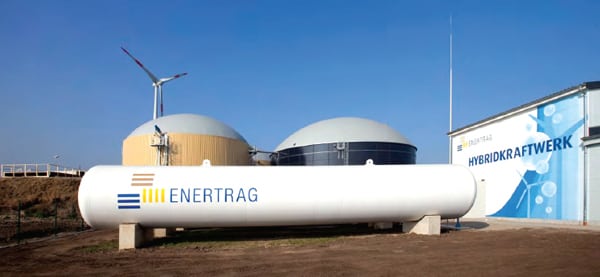European Firms Complete Wind-to-Hydrogen Power Plant
A consortium of European developers, with funding from the German federal government, have completed a power plant in Prenzlau, near Berlin, Germany, that uses excess wind energy to convert water into oxygen and hydrogen in a process called hydrolysis, and then uses hydrogen and biogas to generate power and heat. The project is part of a trend in the research and development of converting renewable energy into hydrogen gas for energy storage.
The 6-MW hybrid Prenzlau plant was completed in October, two years after construction began, by the Performing Energy Alliance for Hydrogen from Wind. That initiative was spearheaded by Swedish power utility Vattenfall and includes energy supplier Enertrag, French oil and gas company Total, Siemens Energy, and German state-funded research institutions and environmental organizations.
The plant consists of a biogas unit, three 2-MW wind turbines, two combined heat and power plants, and a hydrolysis unit (Figure 1). Hydrogen is extracted in times of strong winds and low energy demand and then used on windless days, together with biogas, to generate electricity and heat. According to Vattenfall, hydrogen can also be used in its pure form in cars with fuel cells.
 |
| 1. A gas guzzler. Backed by the German government, the Performing Energy Alliance for Hydrogen from Wind—an initiative that includes energy companies and research and environmental organizations—completed a plant near Berlin that converts water into oxygen and hydrogen, using excess wind energy, in a process called hydrolysis. Courtesy: Enertrag |
Beyond some technical challenges, before the technology used by the project can be widely accepted, it must overcome cost issues, the German government noted in December. The plant cost €21 million ($27.3 million), and at an estimated €3.5 million/MW ($4.6 million/MW), the plant is significantly more expensive than a conventional gas or coal power station, which delivers power at between €1 million and €1.5 million/MW ($1.3 million to $1.95 million/MW). “Continuous technological development is therefore needed to significantly reduce these costs,” it said.
Despite cost challenges, Vattenfall and its partners now plan to expand their pilot activities to store wind power by generating hydrogen in several major projects, including one in the German state of Brandenburg. “There is currently no system designed to compensate for the differences between supply and demand within the sector of renewable energy. But this project allows us to find a balance in the system and it’s also good business,” Oliver Weinmann, head of Vattenfall Innovation in Germany, told POWER in December.
The Prenzlau project joins several development efforts to produce and store hydrogen using surplus power generated by renewables. Similar measures have been taken since 2008 at Gas Natural Fenosa’s $2.2 million Sotavento Experimental Wind Farm in Spain. That process uses an electrolyzer of 60 normal cubic meters per hour, which works on power produced from wind turbines. The electrolyzer produces hydrogen of a low pressure, which is compressed, stored, and later converted to power using a 60-kW generator.
The U.S. National Renewable Energy Laboratory and Minnesota-based utility Xcel Energy in 2007 launched a wind-to-hydrogen (Wind2H2) demonstration project at the National Wind Technology Center in Boulder, Colo. The Wind2H2 project links wind turbines to electrolyzers, which, like the Prenzlau project, pass wind-generated power (using 100-kW and 10-kW turbines) through water to split it into hydrogen and oxygen. The hydrogen can then be stored and used later to generate electricity from an internal combustion engine or a fuel cell.
Meanwhile, other researchers are taking development a step further, producing methane from hydrogen and carbon dioxide with the help of a catalyst. Prominent in this field are the Center for Solar Energy and Hydrogen Research Baden-Württemberg in Stuttgart, Germany, and the Fraunhofer Institute for Wind Energy and Energy System Technology in Kassel, Germany. Those entities have teamed up with Austrian energy company Solar Fuel Technology to build a pilot facility in which hydrogen is “methanized” with an efficiency of around 80%. The researchers say that as soon as this methanization process can be reproduced on an industrial scale, producers can begin pumping the resulting synthetic natural gas into storage facilities in Germany.
—Sonal Patel is POWER’s senior writer.